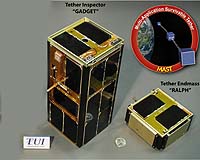 |
Wallops Island VA (SPX) May 21, 2009 NASA's PharmaSat nanosatellite successfully launched at 7:55 p.m. EDT Tuesday from NASA's Wallops Flight Facility and the Mid-Atlantic Regional Spaceport located at Wallops Island, Va. PharmaSat rode to orbit aboard a four-stage Air Force Minotaur 1 rocket. Also aboard were the Air Force Research Laboratory's TacSat-3 satellite and other NASA CubeSat Technology Demonstration experiments, which include three four-inch cubed satellites developed by universities and industry. PharmaSat will investigate the effects of antifungal agents on the growth of yeast in microgravity. This research could improve understanding of how microbes may become resistant to the drugs used to treat sick astronauts on long-duration space missions. "After a spectacular launch as a hitchhiker on the Tacsat-3 mission, we made contact with PharmaSat and confirmed that the spacecraft deployed successfully," said Bruce Yost, PharmaSat mission manager at NASA's Ames Research Center in Moffett Field, Calif. "The PharmaSat mission and science teams are now preparing to complete the experiment on the yeast cultures." Approximately 20 minutes after launch, PharmaSat separated from the Minotaur 1 rocket and entered low Earth orbit at an altitude of approximately 285 miles. About an hour after launch, NASA spaceflight engineers made contact with PharmaSat. After a spacecraft checkout period, ground controllers will command PharmaSat to initiate its biological experiment, which will last approximately 96 hours. Now that PharmaSat is activated and has begun transmitting radio signals to ground control stations at SRI International in Menlo Park, Calif., and Santa Clara University in California, it will send mission data to the NASA Mission Management Team at NASA's Ames Research Center. The nanosatellite could transmit data for as long as six months. The TacSat-3 launch was the third Minotaur vehicle launched from the Mid-Atlantic Regional Spaceport's launch pad 0B on the southern end of Wallops Island. Air Force Space Command's Space and Missile Systems Center's Space Development and Test Wing at Kirtland AFB, N.M., has overall management of the mission. The Exploration Technology Development Program in NASA's Exploration Systems Mission Directorate at NASA Headquarters in Washington funded the PharmaSat project. Share This Article With Planet Earth
Related Links PharmaSat Microsat News and Nanosat News at SpaceMart.com
 Croatia To Launch Satellite Into Space
Croatia To Launch Satellite Into SpaceZagreb, Croatia (JNA) May 04, 2009 Croatia has started a space programme on May 1: a planned science-exploration and educational project in the area of space technologies. The project was envisioned by the Vidulini astronomy association. The association`s representatives point out that their mission is to envision, construct, use various technical achievements, explore and hold educational activities with the goal of ... read more |
|
| The content herein, unless otherwise known to be public domain, are Copyright 1995-2009 - SpaceDaily. AFP and UPI Wire Stories are copyright Agence France-Presse and United Press International. ESA Portal Reports are copyright European Space Agency. All NASA sourced material is public domain. Additional copyrights may apply in whole or part to other bona fide parties. Advertising does not imply endorsement,agreement or approval of any opinions, statements or information provided by SpaceDaily on any Web page published or hosted by SpaceDaily. Privacy Statement |